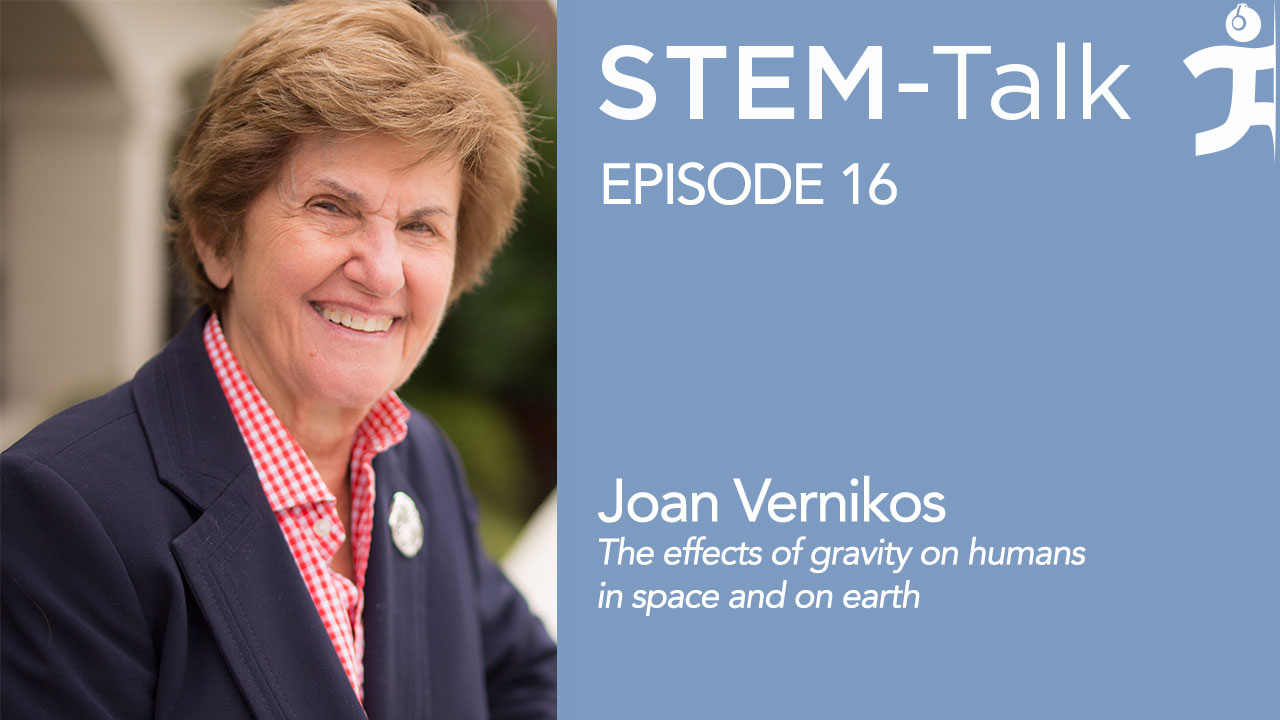STEM-Talk
Episode 16: Joan Vernikos discusses the effects of gravity on humans in space and on earth.
// Jul 19, 2016

If you want to feel like an astronaut, lie in bed all day. That may seem counter-intuitive, but the body experiences the two scenarios in a similar way. The absence of gravity in space mimics the affects of lying down flat—and not using gravity to our physiological advantage.
Gravity expert Joan Vernikos talked about this and other insights on how gravity affects us, in this episode of STEM-Talk, hosted by Dawn Kernagis and Tom Jones. Vernikos spoke to them right before her IHMC lecture in Pensacola, entitled, “Gravity is Our Friend”
Vernikos’ first mentor in life was her father, who at 17 years of age, left his native Greece for France, determined to study medicine, which he did. His specialization in infectious diseases took him to Egypt, where Joan and her sister were educated at English boarding schools. Her sister became a physician, while Joan “chickened out,” becoming a pharmacologist instead.
After entering academia, she was recruited to NASA, where she became the director of the Life Sciences Division.
Since retiring from NASA 16 years ago, Vernikos says that she’s had “a lot more time to think.” She is the author of the provocatively-titled book, “Sitting Kills, Moving Heals,” which was published in 2011. Her forthcoming book, “Designed to Move,” is about how sedentary lifestyles contribute to poor health and early death; and how movement that challenges gravity can dramatically improve life and longevity.
A dynamic speaker, Dr. Vernikos has given dozens of lectures, some of which can be found at https://www.youtube.com/results?search_query=YouTube.com%2FDrJoanVernikos. You can also check out her web site at www.joanvernikos.com
00:47: Ken Ford describes Vernikos as a pioneer in how living in a micro-gravity environment adversely affects astronauts, compared to the benefits of gravity for those of us on earth. “Living in space is like accelerated aging,” she says—which might be instructive for thinking about preventing and treating age-related conditions such as sarcopenia and osteoporosis.
2:01: IHMC Director Ken Ford reads a 5-star iTunes review from “Fellow Musician”: “Unlike the majority of podcasts I find, STEM-Talk is a long format show with extremely in-depth discussions. I can’t believe how much serious information was packed into the first few episodes. A plus.”
2:25: Dawn gives a brief bio of Vernikos, as the former director of life sciences at NASA, who pioneered research in how living in a micro gravity environment adversely affects the health of astronauts. She also studied the effects of microgravity on the physiology of astronauts in space and aging on earth.
3:37: Vernikos talks about the influence of her physician-father, her first mentor. “I learned by apprenticeship, which is the best way to learn.”
5:05: “What I learned from father, which is fundamental to my approach, is that you listen, you ask questions, and you diagnose …. He would discuss cases at the dinner table; he would ask us, what would we do in that case. That was a fantastic preparation that served me well.”
6:24: In Egypt, which was then a British protectorate, Vernikos went to an all-girls’ English school, with other girls of 27 different nationalities. She studied pharmacy at the University of Alexandria, and then pharmacology in the U.K.
8:00: Vernikos talks about a Greek woman physician who was also a mentor. This woman developed the first drugs that lower blood pressure. “She was very unusual…headstrong…attractive…She insisted we go to the hairdresser every week.”
10:23: Commercial break: STEM-Talk is an educational service of the Florida Institute for Human and Machine Cognition, a not-for-profit research lab pioneering ground-breaking technologies aimed at leveraging human cognition, perception, locomotion and resilience.
10:50: Vernikos describes her jump from academia to NASA. She was teaching pharmacology at Ohio State, and the physiology chair there was hired at NASA to start a group in biology/biomedical sciences. He needed someone in the stress business, and picked Joan.
12:36: Vernikos talks about her frustrations in pitching gravity as a medical issue to physicians. “To this day, the word gravity has not made it into the medical school textbooks.”
12:57: “I was very fortunate in my career; I never had to apply for a job. Somehow or other, I was invited to do something and it happened.” As such, she was tagged to become the Life Sciences Division Director at NASA. “I ended up in headquarters, which meant it was the end of my research career, but I never really stopped doing research.”
14:12: She calls her role there “very international” in terms of collaborating with the scientific community. She also managed the Division’s budget.
16:37: The program was observational, she said. “Every bit of information was cumulative in figuring out that gravity was more important than we thought.”
17:50: They discovered that in space, muscle wasting occurred, first because of dehydration. Muscles and bones also atrophied. Animal experiments showed that within six hours of flight, protein synthesis stopped in muscles and bones. “The signal for synthesis was gravity-related.”
20:20: She cites other cardiovascular changes: the heart got smaller, and cardiac output was reduced. The endothelium gradually disappeared with time. Joints, ligaments, collagens were lost.
20:53: “It’s not a catabolic state, but it’s a wasting state,” she said, of the micro-gravity environment experienced by astronauts.
21:17: “I think we’re flogging the same thing over and over again,” she said, in answer to Tom Jones’ question: ‘Do astronauts today preserve bone, muscle strength?’
22:03: “All the data we have in space is in the presence of the exercise countermeasure.”
24:29: “Since I left NASA 16 years ago, I had time to think, which I didn’t have when I worked there.”
24:58: “We never really sat down and asked: ‘What is the signal the body sees? / What do you need to replace?’”
25:45: The stimulus that is needed to maintain a physiologically-intact body in a gravity micro-environment is low intensity/high frequency intermittent exposure to gravity.
26:12: The minute you stop exercising in space, you revert to a micro-gravity environment. That is not true on earth. Exercise on earth is different. The minute you stop you are still in gravity.
26:40: The space exercise experiments of astronaut Steve Hawley—who purports to have exercised as hard as he possibly could in space, then felt completely normal in the aftermath—made Vernikos conclude: “We should map what happens right after exercise. To this day, no one has looked at after-effects of exercise.”
27:54: “We are perpetual motion machines. We need to move…exercise every day does not counter act all the sitting we do.”
28:34: We need intermittent gravity stimuli for at least 16 hours a day.
29:42: Even just standing up, if it’s frequent, is better than shorter-term walking.
30:33: Vernikos says astronauts need an artificial gravity device that they can get on and off of easily, many times a day.
31:48: All of the body needs to be stimulated, especially the vestibular system, “the clearing house for blood pressure regulation,” as well as other activities central to the bone and muscle. “When the vestibular system goes silent, you’re in trouble.” Calls for systematic research on future implants.
35:20: Jones says that it took three days for his coordination and balance to come back after space flight. That’s because the maps in the brain telling you where you are in environment disappear.
38:00: A form of anabolic resistance may be at work in space…It’s similar to what happens when you lie in bed.
40:50: We don’t know how the glymphatic and lymphatic system in the brain are affected by a gravity-less environment. But without gravity, our body’s “whole detox system is fouled up.”
43:48: All impediments to detoxification result in inflammation. In space, the body is in a state of chronic inflammation, not to mention stress.
44:25: In space, the light intensity and light cycles are altered. Sleep is not sleep; there is an accumulation of carbon dioxide. “The whole life support system must be looked at again. These are crucial to the design of exploration missions, before we even begin to think about the counter measures.”
48:58: “I think it’s crucial that astronauts go on the ketogenic diet. There is a good chance that it will protect them, preventing a variety of conditions, including inflammation.”
50:00: Vernikos compares astronauts to hibernating animals, who don’t lose muscle and bone while hibernating. Their body temperature drops a little; they rely on fat for energy. They breathe more slowly; and even go through pregnancy.
51:17: Astronauts have trouble sleeping and do not feel refreshed when they wake up. Sleep is important for cognitive function.
53:55: “I firmly believe that space has revealed how gravity affects us here on earth; how it is important to our well-being; and how we should use it to maintain our health.”
55:42: The less we move the more like astronauts we become. The changes in bone loss, from one percent a year on earth to 10-20 percent a year in space has confirmed a ten-fold greater loss of bone in space than on earth.
57:05: From age twenty on, we sit more and more. We are designed to move. One time a day exercise is not enough to counteract the absence of movement throughout the day.
1:00:45: Vernikos discusses her book, “Sitting Kills, Moving Heals.” The catchy title brought initial attention to the book, and public interest in it has grown. She highlights the importance of the last, and often over-looked, chapter called gravity therapy.
1:03:29: Vernikos discusses certain longevity secrets of Greeks. Among them: they use their arms when they speak (part of using gravity); they follow a mostly ketogenic diet; their movement, socialization, and emotional expressiveness is all is conducive to longevity.
1:04:53: Longevity in rural areas is greater—in Greece and around the world.
1:05:32: In her free time, Vernikos reads mysteries. “I feel science is a mystery. I think I am a sleuth who solves a problem.”
1:06:11: She says, “I don’t like studying the human body in pieces. It is a whole; you have to look at the whole picture and see how your approach can solve the problem.”
1:07:21: Dawn and Tom thank Vernikos.
1:07:39: Ford sums up Vernikos’ driving message: “Our willingness to interact with gravity will substantially improve how we age.”
1:08:20: Dawn and Ken sign off.






